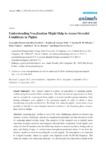Use este identificador para citar ou linkar para este item:
http://www.alice.cnptia.embrapa.br/alice/handle/doc/966129Registro completo de metadados
| Campo DC | Valor | Idioma |
|---|---|---|
| dc.contributor.author | CORDEIRO, A. F. da S. | pt_BR |
| dc.contributor.author | NÄÄS, I. de A. | pt_BR |
| dc.contributor.author | OLIVEIRA, S. R. de M. | pt_BR |
| dc.contributor.author | VIOLARO, F. | pt_BR |
| dc.contributor.author | NEVES, D. P. | pt_BR |
| dc.date.accessioned | 2013-09-12T11:11:11Z | pt_BR |
| dc.date.available | 2013-09-12T11:11:11Z | pt_BR |
| dc.date.created | 2013-09-12 | pt_BR |
| dc.date.issued | 2013 | pt_BR |
| dc.identifier.citation | Animals, v. 3, n. 3, p. 923-934, 2013. | pt_BR |
| dc.identifier.uri | http://www.alice.cnptia.embrapa.br/alice/handle/doc/966129 | pt_BR |
| dc.description | Abstract: Assessing pigs? welfare is one of the most challenging subjects in intensive pig farming. Animal vocalization analysis is a noninvasive procedure and may be used as a tool for assessing animal welfare status. The objective of this research was to identify stress conditions in piglets reared in farrowing pens through their vocalization. Vocal signals were collected from 40 animals under the following situations: normal (baseline), feeling cold, in pain, and feeling hunger. A unidirectional microphone positioned about 15 cm from the animals? mouth was used for recording the acoustic signals. The microphone was connected to a digital recorder, where the signals were digitized at the 44,100 Hz frequency. The collected sounds were edited and analyzed. The J48 decision tree algorithm available at the Weka® data mining software was used for stress classification. It was possible to categorize diverse conditions from the piglets? vocalization during the farrowing phase (pain, cold and hunger), with an accuracy rate of 81.12%. Results indicated that vocalization might be an effective welfare indicator, and it could be applied for assessing distress from pain, cold and hunger in farrowing piglets. | pt_BR |
| dc.language.iso | eng | eng |
| dc.rights | openAccess | eng |
| dc.subject | Algoritmo | pt_BR |
| dc.title | Understanding vocalization might help to assess stressful conditions in piglets. | pt_BR |
| dc.type | Artigo de periódico | pt_BR |
| dc.date.updated | 2014-02-04T11:11:11Z | pt_BR |
| dc.subject.thesagro | Suíno | pt_BR |
| dc.subject.thesagro | Suinocultura | pt_BR |
| dc.subject.nalthesaurus | Swine | pt_BR |
| dc.subject.nalthesaurus | Young animals | pt_BR |
| dc.subject.nalthesaurus | Piglets | pt_BR |
| dc.subject.nalthesaurus | Algorithms | pt_BR |
| dc.subject.nalthesaurus | Mathematical models | pt_BR |
| riaa.ainfo.id | 966129 | pt_BR |
| riaa.ainfo.lastupdate | 2014-02-04 | pt_BR |
| dc.identifier.doi | 10.3390/ani3030923 | pt_BR |
| dc.contributor.institution | ALEXANDRA FERREIRA DA SILVA CORDEIRO, Unicamp; IRENILZA DE ALENCAR NÄÄS, UNICAMP; STANLEY ROBSON DE MEDEIROS OLIVEIRA, CNPTIA; FABIO VIOLARO, Unicamp; DIEGO PEREIRA NEVES, Unicamp. | pt_BR |
| Aparece nas coleções: | Artigo em periódico indexado (CNPTIA)  | |
Arquivos associados a este item:
| Arquivo | Descrição | Tamanho | Formato | |
|---|---|---|---|---|
| animals0300923.pdf | 1,42 MB | Adobe PDF |  Visualizar/Abrir |









